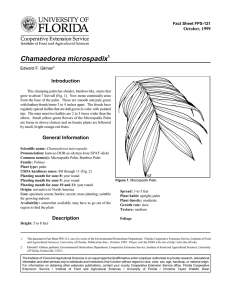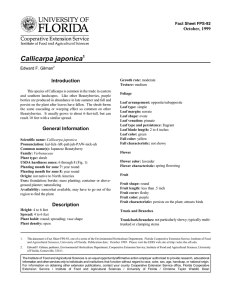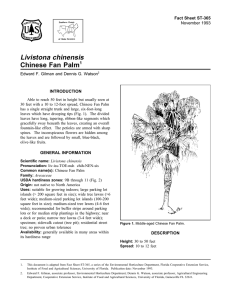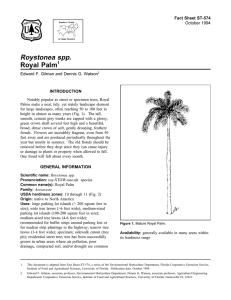Chamaerops humilis Introduction October, 1999 Fact Sheet FPS-123
advertisement
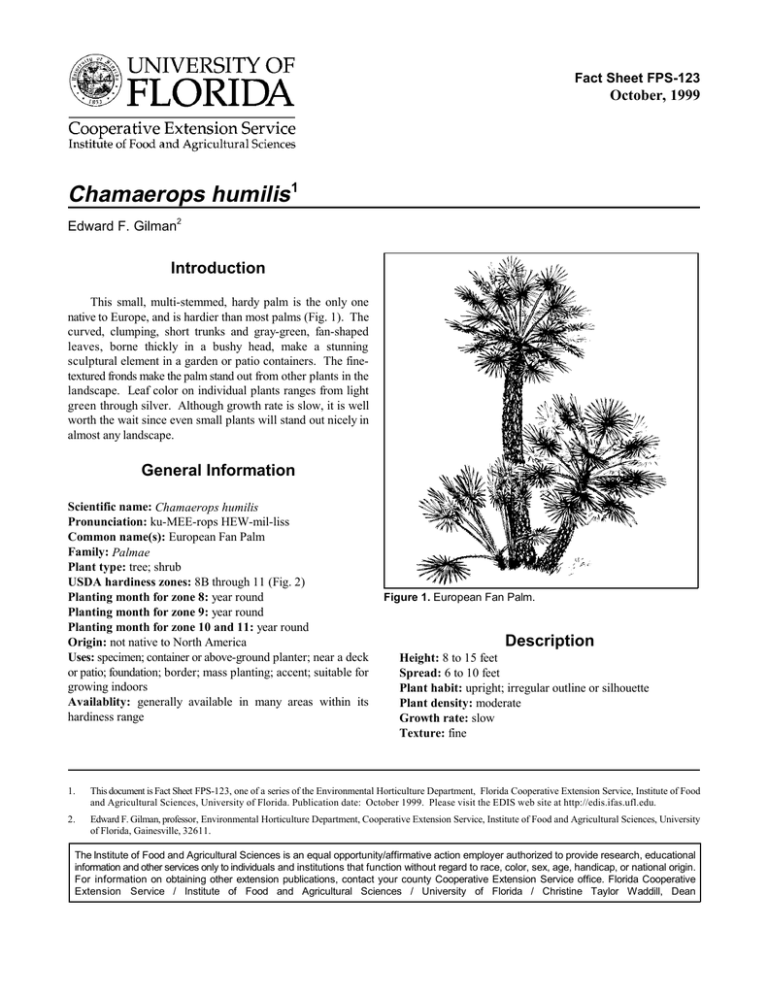
Fact Sheet FPS-123 October, 1999 Chamaerops humilis1 Edward F. Gilman2 Introduction This small, multi-stemmed, hardy palm is the only one native to Europe, and is hardier than most palms (Fig. 1). The curved, clumping, short trunks and gray-green, fan-shaped leaves, borne thickly in a bushy head, make a stunning sculptural element in a garden or patio containers. The finetextured fronds make the palm stand out from other plants in the landscape. Leaf color on individual plants ranges from light green through silver. Although growth rate is slow, it is well worth the wait since even small plants will stand out nicely in almost any landscape. General Information Scientific name: Chamaerops humilis Pronunciation: ku-MEE-rops HEW-mil-liss Common name(s): European Fan Palm Family: Palmae Plant type: tree; shrub USDA hardiness zones: 8B through 11 (Fig. 2) Planting month for zone 8: year round Planting month for zone 9: year round Planting month for zone 10 and 11: year round Origin: not native to North America Uses: specimen; container or above-ground planter; near a deck or patio; foundation; border; mass planting; accent; suitable for growing indoors Availablity: generally available in many areas within its hardiness range Figure 1. European Fan Palm. Description Height: 8 to 15 feet Spread: 6 to 10 feet Plant habit: upright; irregular outline or silhouette Plant density: moderate Growth rate: slow Texture: fine 1. This document is Fact Sheet FPS-123, one of a series of the Environmental Horticulture Department, Florida Cooperative Extension Service, Institute of Food and Agricultural Sciences, University of Florida. Publication date: October 1999. Please visit the EDIS web site at http://edis.ifas.ufl.edu. 2. Edward F. Gilman, professor, Environmental Horticulture Department, Cooperative Extension Service, Institute of Food and Agricultural Sciences, University of Florida, Gainesville, 32611. The Institute of Food and Agricultural Sciences is an equal opportunity/affirmative action employer authorized to provide research, educational information and other services only to individuals and institutions that function without regard to race, color, sex, age, handicap, or national origin. For information on obtaining other extension publications, contact your county Cooperative Extension Service office. Florida Cooperative Extension Service / Institute of Food and Agricultural Sciences / University of Florida / Christine Taylor Waddill, Dean Chamaerops humilis -- European Fan Palm Page 2 Figure 2. Shaded area represents potential planting range. Foliage Trunk and Branches Leaf arrangement: alternate Leaf type: simple Leaf margin: lobed Leaf shape: star-shaped Leaf venation: palmate Leaf type and persistence: evergreen Leaf blade length: more than 36 inches Leaf color: silver/gray; blue or blue-green Fall color: no fall color change Fall characteristic: not showy Flower Flower color: yellow Flower characteristic: spring flowering Trunk/bark/branches: showy; typically multi-trunked or clumping stems; can be trained to grow with a short, single trunk Current year stem/twig color: not applicable Current year stem/twig thickness: not applicable Culture Light requirement: plant grows in part shade/part sun Soil tolerances: alkaline; clay; sand; acidic; loam Drought tolerance: high Soil salt tolerances: poor Plant spacing: 36 to 60 inches Fruit Fruit shape: round Fruit length: less than .5 inch Fruit cover: dry or hard Fruit color: brown Fruit characteristic: inconspicuous and not showy October 1999 Chamaerops humilis -- European Fan Palm Page 3 Other Roots: usually not a problem Winter interest: no special winter interest Outstanding plant: not particularly outstanding Invasive potential: not known to be invasive Pest resistance: long-term health usually not affected by pests Use and Management By removing suckers from the base of the main trunk, this slightly salt-tolerant palm may also be trained as a singletrunked palm. Since the leaf stalks are spiny, Fan Palm may also be used as a barrier, planted three to five feet apart. It makes a nice accent plant in a shrub border or in a low-growing groundcover. It can also be planted several feet apart in a mass on a large-scale landscape forming a fine-textured accent area. Growing best in moist rich soil, it is drought- and windresistant, and established plants will survive temperatures to 10degrees F. or below, in full sun or light shade. Plants grow very slowly in the shade. Propagation is by seed or division. Scale may be a problem. Pests and Diseases No diseases are of major concern. October 1999


